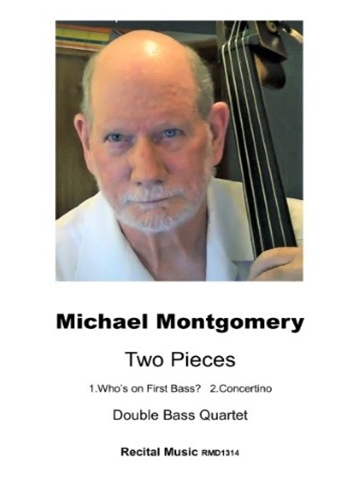Two Pieces for Double Bass Quartet

| Product Code: | RMD1314 |
| Publishers Number: | RMD1314 |
| Language: | English |
| Condition: | New |
2. Concertino’
He now lives in the Ozark Mountains of Arkansas, where he teaches double bass at the University of Arkansas Fayetteville and privately in his home studio. Michael has composed numerous works for young double bassists (including over five dozen short bass quartets for young students) which are published by Recital Music and two American publishers.
His articles about bass performance, literature, and teaching have been published in American Suzuki Journal, Bass World, and Pastoral Music.
Michael Montgomery's Two Pieces -Who's on First Bass?' and 'Concertino' – exists in a number of orchestrations – for double bass and string orchestra, double…
Michael Montgomery writes:
“Who’s on First Bass? is a short solo for double bass and string orchestra and written for David S., a young middle school bassist, at the request of his orchestra teacher.
David had progressed wonderfully in his second year of study, catching the attention of the teacher, who wished to feature him in the end of the year Spring concert. With the unfortunate happenings of the pandemic, however, face to face class meetings were suspended, the academic school year was completed via online remote learning, and the Spring concert had to be cancelled – David’s moment in the spotlight would have to wait.
The title is, of course, a takeoff on the “Who’s on First” comedy routine of Abbott and Costello in which the player Who actually is on first base. In this piece the soloist is accompanied by string orchestra (or string quintet) with a subtle (yet quite important) part added for claves.
Here the typical five note rhythmic pattern of Cuban Salsa (the “clave”, literally the key) is altered slightly, with the second note of the rhythm occurring on beat three rather on the “and” of two.
This clave is indeed the key to much of the rhythmic material in the solo and string parts, especially the manner in which the downbeat of the second measure (of the two measure clave) is anticipated.”
Concertino was written for graduating high school senior Isaac A. and was meant to be performed by Isaac at his final concert with the Rogers High School Orchestra.
High school seniors across the country were, as we know, deprived of the many ceremonies that define for them and their families this moment in their lives, so Isaac is by no means alone in his disappointment.
The piece remains as a memento of this rite of passage and hopefully for Isaac there will be another opportunity for a performance.
The rather marked punctuation of the accompaniment stands in stark contrast to the somewhat flowing manner of the solo bass part throughout the first section of the piece, but gives way leading into measure thirty to more relaxed and almost naïve set of arpeggiated figures in the measures that follow.
The solo part itself changes register quickly, rising across its two octave range in the first measure of sounding. That being said, this solo should be easily accessible to any high school senior who has been conscientious in his study of the instrument.”
R.R.P £8.50
Our Price: £6.80
Digital Download – PDF
Shipping costs: No shipping
You might also like
-
12 Waltzes for Double Bass
£6.80 -
20 Melodic Pieces Book 1
£6.80 -
3 Pieces for Double Bass and Piano
£10.00 -
3 Random Rambles
£6.80




